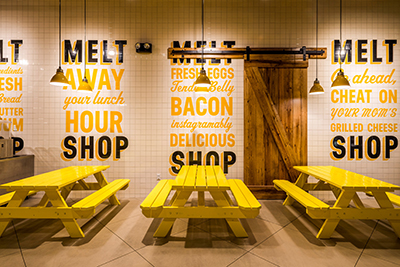The 2023 “State of Restaurants” Report released today by TouchBistro reveals that restaurant sales in the U.S., on average, have recovered to approximately 75% of pre-pandemic levels, with three-in-five operators reporting that their sales volume has returned to at least 50% of pre-pandemic levels. However, due to the rising cost of food and other expenses, profit margins stayed relatively steady for full service restaurants (FSRs) at 10.6%, with the exception of larger restaurants – specifically those with 120 seats or more – who report seeing profit margins as high as 13%. The report also identifies five emerging trends that can help restaurateurs navigate the year ahead.
TouchBistro’s ‘State of Restaurants’ Report: Sales Recovering, Profits Squeezed by Rising Costs
Available for free download from touchbistro.com/blog/state-of-restaurants-report, the 2023 “State of Restaurants” Report finds more than half (54%) of restaurateurs say that inventory is their biggest source of financial strain, up significantly from 2021 when just 33% cited it as their top concern. To deal with rising food costs, more than half (53%) of restaurateurs say they raised their menu prices in the past six months, with operators increasing prices by 15% on average. Rent (23%) and labor (22%) were also cited as major sources of financial strain.
“After contending with the worst of the pandemic, many restaurants had their sights set on a more successful 2022, but it’s been a mix of highs and lows,” says Samir Zabaneh, CEO of TouchBistro. “Now, as the restaurant industry enters another year characterized by economic instability and change, many operators are once again preparing to adjust the way they run their businesses. Some have invested in technology that can help them adapt to changing business conditions quickly and efficiently, while others have found creative ways to keep expenses down and profits up. Managing these changes certainly won’t be easy, but if the last few years have proven anything, it’s that the restaurant industry always finds a way to adapt.”
National Highlights from the 2023 State of Restaurants Report
- Staffing and Labor: Despite relatively low unemployment rates nationwide, the restaurant industry continued to face record labor shortages. Now, 97% of restaurateurs say they are short at least one position and, on average, they report being short five positions. 59% of operators report offering higher wages to stay competitive, while nearly half (49%) also offer professional development opportunities to stay competitive (up from 39% last year).
- Inventory and Menu Management: With rising food costs cutting into profits, 40% of operators say they are finding new, less expensive suppliers to help them reduce expenses. Nearly a third (32%) of operators say they are swapping expensive ingredients for cheaper substitutes as a way to reduce costs, while 27% say they are eliminating certain menu items entirely.
- Takeout and Delivery: 97% of restaurants now report using at least one online ordering platform and, on average, most use three platforms. Nearly a third (34%) of those operators offer direct online ordering from their restaurant’s website, suggesting that most operators prefer to use a mix of direct and third-party online ordering systems.
- POS and Payments: Operators invested heavily in new technology this past year with 76% reporting that they changed their POS system and two-thirds (66%) of restaurants using a system with an integrated payment processing solution.
- Marketing and Loyalty: While Facebook remains the most popular social media platform for restaurateurs with 61% using it to promote their restaurant, TikTok is not far behind with 40% of operators using the platform. Additionally, SMS (texting) was cited as the number one way restaurants stay in touch with customers.
- Reservations: While many restaurants put reservations on pause during the pandemic, the practice now seems to be making a comeback. In fact, 76% of restaurateurs now say they take reservations, and 81% report using an online reservations system to manage their bookings.
Five Emerging Trends to Help Restaurants Navigate the Year Ahead
Findings from the 2023 “State of Restaurants” Report reveal five emerging trends that can help restaurant operators navigate the year ahead.
- Calculated Price Changes: While many diners are sympathetic and willing to tolerate some price increases, there are also signs they are starting to tighten their wallets. Restaurateurs should be careful to keep price increases to a minimum where possible to avoid giving diners a serious case of sticker shock and driving business away. Overall, most operators reported raising their prices by 15% on average, which appears to be the maximum increase most consumers are willing to absorb. Operators should keep this figure in mind and evaluate the potential business implications when considering any further increases.
- Menu Flexibility: One-in-five operators (20%) said that ingredient shortages was their number one inventory challenge this year, revealing just how dire the situation has become. In response, many operators have learned to be more flexible when it comes to their menus and specials. Whether it’s switching suppliers, sourcing ingredients locally, finding substitutes for certain ingredients, or adjusting portion sizes, it’s essential for operators to look for opportunities to build more flexibility into their menus so they can better adapt to ongoing ingredient shortages.
- Refocusing on Retention: While the number one demand from employees is for higher wages, operators can also explore other ways to keep staff happy like benefits and professional development opportunities. Although this may seem like an added expense, it’s worth noting that the average cost of training a new employee has risen to a whopping $3,959, suggesting that retention might actually be the most financially savvy staffing solution.
- The TikTok Turning Point: Many operators report using TikTok over Instagram, which seems to be moved out of the spotlight, especially in major restaurant hubs like New York City. In fact, many operators reported customers coming in after watching a video on TikTok. While restaurateurs should not put all their efforts into one social media platform, it’s clear that TikTok is a platform worth investing in if operators want to continue attracting new diners.
- POS Systems that Do It All: Operators are increasingly realizing the value of having a modern POS that can not only take orders, but also handle payments, support a loyalty program, process online orders, track reservations, and more. Nearly a third (30%) of operators said that the ability to integrate with other third-party software was a top factor they considered when choosing a new POS system, suggesting that having everything accessible through one platform is increasingly preferred.
About The State of Restaurants Report
Now in its fifth year, the study was conducted by research firm Maru Matchbox on behalf of TouchBistro in September 2022. More than 600 full service restaurant owners, presidents, and area/general managers were surveyed across all 50 states with an added focus on six key cities: New York City, Los Angeles, Chicago, Dallas, Houston, and Miami. Survey results are accurate +/- 4% 19 times out of 20. The detailed findings on this research by Maru Public Opinion are available at: Maru Public Opinion US.
Read Also: Uncle Waithley’s Vincy Brew: Ginger Beer with Scotch Bonnet
About TouchBistro
TouchBistro is an award-winning restaurant management system that makes running a restaurant easier by providing essential front of house, back of house, and guest engagement solutions and POS, on one powerful platform. TouchBistro helps restaurateurs streamline and simplify their operations, increase sales, and deliver a great guest experience. For additional information, visit TouchBistro.com.







